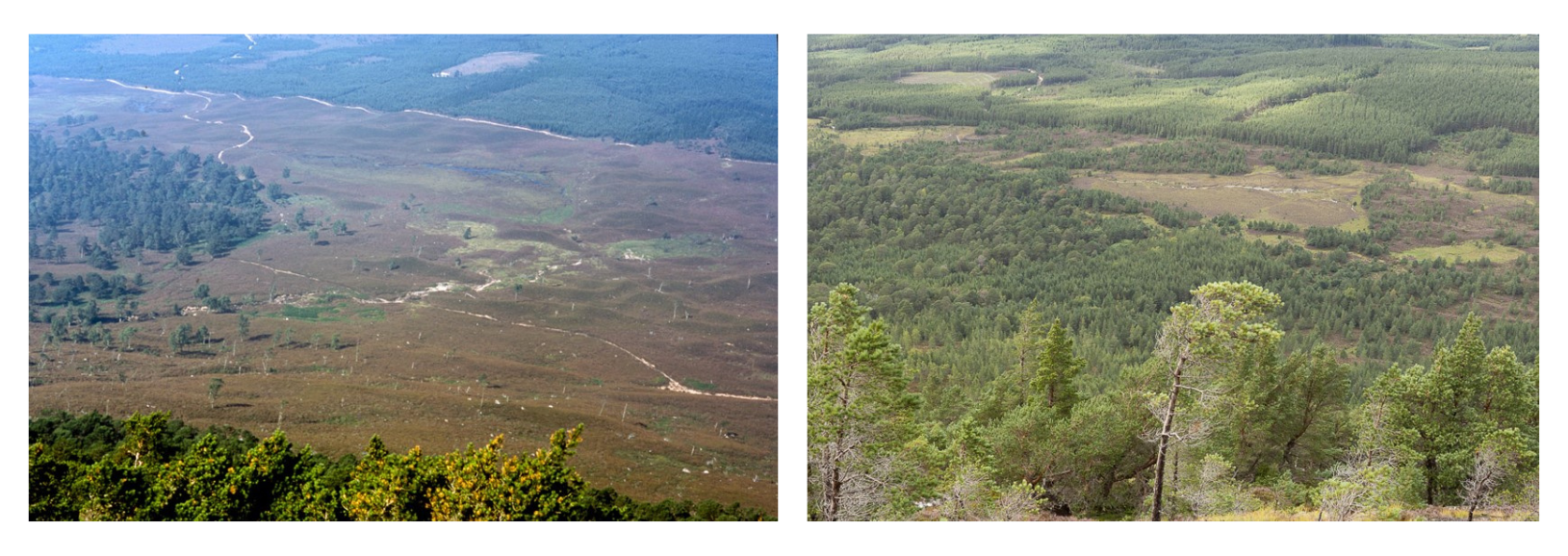

Newly published Cairngorms Connect research demonstrates potential for forest regeneration in Scottish Highlands. By Dr Pip Gullett.
If you imagine walking through the British uplands, you probably picture wide open views and hillsides of heather, with the occasional patch of forest and maybe a birch or rowan tree here or there. What you probably don’t picture, is the abundance of native pinewood and broadleaved trees that would once have enriched our uplands.
In Scotland, native pinewoods now cover only about 1% of their former range, following centuries of human intervention – first felling the trees and then grazing the land with livestock. More recently, although livestock numbers have been reduced in many areas, trees have been battling against ever-increasing deer numbers. Whilst red and roe deer are a natural and important part of Scotland’s landscape, a human-induced absence of predators and historic land use means their numbers are unsustainably high over large areas, giving little chance for trees to re-establish in areas where woodland has been lost.
Restoring native woodlands to areas where they have been lost is a top priority for nature conservation and human society, and a key element of tackling the biodiversity and climate crises – this is reflected in significant government targets for expanding the area of native woodland in the UK. In recent years, some land managers have been expanding the area of native woodlands in Britain’s uplands, often through planting trees in fenced areas to protect them from deer. This can be an effective way of re-establishing woodland. But it’s not very… well, ‘natural’… trees and deer have evolved living together, and should be able to coexist in a balanced, healthy ecosystem. Meanwhile, fences are very costly and can cause casualties when unsuspecting wildlife collide with them.

Image (above): Fixed point photography from NatureScot's Invereshie Reserve, showing woodland regeneration between 1973 and 2023. Credit: Ian Sargent
We can argue forever about the meaning of the word ‘natural’ – but suffice it to say, the Cairngorms Connect Partners (Wildland Limited, Forestry and Land Scotland, RSPB Scotland and NatureScot) are working to achieve an ecosystem that can thrive into the future with as little human intervention as possible. We are working towards recreating a self-sustaining, self-regulating ecosystem through restoring natural processes wherever possible, or emulating those processes through human means as a second best. So rather than planting trees in fenced areas, we aim to support trees to regenerate and spread naturally, in the presence of deer at appropriate densities. We use fences only as a last resort, in a small number of specific locations to protect particularly vulnerable tree species.
Working with scientists and land managers from across the Cairngorms Connect Partnership, in a recently published article, we have brought together more than 30 years of data on tree regeneration and deer, from across four neighbouring landholdings, to help us understand whether trees can indeed regenerate across this landscape in the presence of deer. This work was made possible thanks to funding from the Endangered Landscapes Programme, as well as ongoing investment by each of the Cairngorms Connect partners.
Our data show a consistent, large-scale expansion of native woodland, largely through natural regeneration alongside deer culling, without the use of fences and with minimal planting. This was achieved across the Partnership, despite the different land management histories and approaches across the Partnership area. Importantly, we show that woodlands were regenerating and expanding successfully in the presence of deer, as long as deer numbers were kept relatively low for long periods.
Of course, deer are not the only factor influencing woodland expansion – other major factors are seed supply and the existence of suitable ground in which seeds can germinate. Our data suggest that in some cases, these factors are problematic within the Cairngorms Connect area: for instance, some tree species showed little regeneration over parts of our study area. To speed up the process of woodland expansion, our study suggests we might need higher levels of intervention for some tree species and in some particular areas. Cairngorms Connect is now undertaking trials at RSPB Abernethy National Nature Reserve to help inform future decisions regarding when, where and how tree planting or sowing may be best used as management tools to aid and speed up the process of woodland expansion.

Image (above): Fixed point photography from RSPB Scotland's Abernethy National Nature Reserve and Forestry and Land Scotland's Glenmore Forest Park, showing woodland regeneration between 1993, 2016 and 2021.
Overall, we show that aligning deer management across multiple adjoining landholdings can achieve rapid landscape-scale native woodland expansion with minimal need for planting or fencing. Several other landowners elsewhere in Scotland are using similar approaches to restore native woodland at a landscape scale (e.g. Corrour Estate, Trees for Life and Mar Lodge) and we consider that this approach could be more widely adopted in suitable areas across the British uplands. Our results show the power of monitoring regeneration directly, to inform deer management.
By uniting over a shared vision and carefully monitoring landscape change, organisations with differing management approaches and histories can build understanding alongside achieving landscape-scale ecological restoration.
Main image: Dr Pip Gullett. Credit: Rupert Shanks
Rosie Beetschen joins a day of Seed Establishment Trials in the beautiful and remote Strath Nethy to learn about how Cairngorms Connect are working to grow and expand our native forests. Listen or read.
Rosie Beetschen reflects on the Cairngorms Connect Community Conference earlier this month, and an amazing year of projects, fieldwork and volunteering